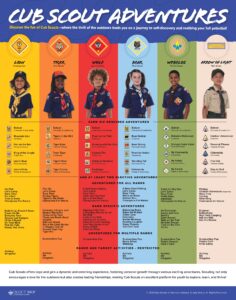Why Join Cub Scouts?
Your time is valuable—Cub Scouting helps you make the most of it with ready-made adventures to enjoy with your child.
What Kids Get
-
A sense of belonging with kids their age
-
Confidence and self-esteem through new skills and achievements
-
Lessons in teamwork, kindness, and “doing their best”
-
Fun first—from building cars and robots to camping, hiking, and archery
What Parents Value
-
A program that teaches character, citizenship, and fitness—values families care about
-
Activities that strengthen family bonds and add meaning to time spent together
-
A safe, welcoming community for all
What Makes It Fun
-
Cool uniforms and recognition with badges, pins, and patches
-
Sports like baseball, soccer, and swimming that build fitness and sportsmanship
-
Hands-on projects in STEM, art, woodworking, and more that spark imagination
-
Outdoor adventures that teach respect for nature
At its core, Cub Scouting is about kids having fun while learning life lessons they’ll carry forever.
How Does Cub Scouting Work?
Cub Scouting is family-centered—you join the adventure right alongside your Scout. Each grade has its own handbook with age-appropriate adventures. As Scouts complete activities with your support, they earn badges and awards to proudly wear on their uniform.
Your involvement is key: the more you participate, the more your child grows, learns, and succeeds in Scouting.
Here’s some more useful information on Cub Scouting.
How Do Packs and Dens Work?
Cub Scouting happens at two levels:
-
Dens – Small groups of Scouts in the same grade who work on age-appropriate adventures together.
-
Pack – All dens (K–5) come together as one big group.
Pack 3807 meets twice a month, with families and siblings always welcome. Meetings start with opening rituals and awards for Scouts’ recent achievements. Then dens break out for rank-specific activities before regrouping to share new skills and celebrate progress.
Here is some additional information on how a Cub Scouts unit is organized.
How Does Advancement Work?
Scouts progress rank by rank, with each level introducing new skills and age-appropriate challenges. Advancement includes a mix of individual and group adventures that keep learning fun.
To earn a rank, Scouts must complete:
-
6 required adventures
-
At least 2 elective adventures
These requirements should be finished by June of the program year. If not, the Scout will begin the next rank with their grade or age level.
Every step of advancement is designed to build a child’s character, fitness, and confidence—all while keeping the focus on adventure and fun.
Lion (Kindergarten) – First steps in Scouting, simple group fun and discovery
Tiger (1st Grade) – Learning teamwork and trying new activities with family
Wolf (2nd Grade) – Building skills and independence through hands-on projects
Bear (3rd Grade) – Exploring the outdoors, creativity, and responsibility
Webelos (4th Grade) – Developing leadership, outdoor skills, and self-reliance
Arrow of Light (5th Grade) – Preparing for Scouts BSA with advanced adventures
The Cub Scout Advancement Trail

